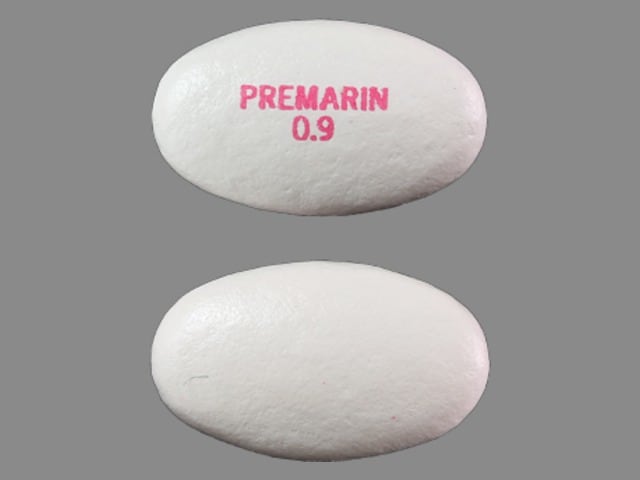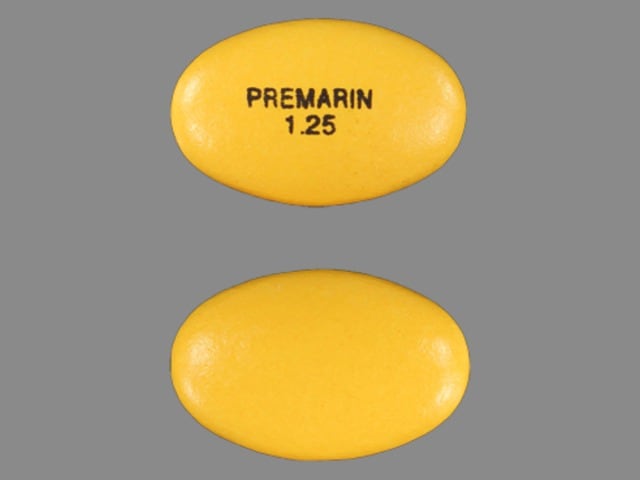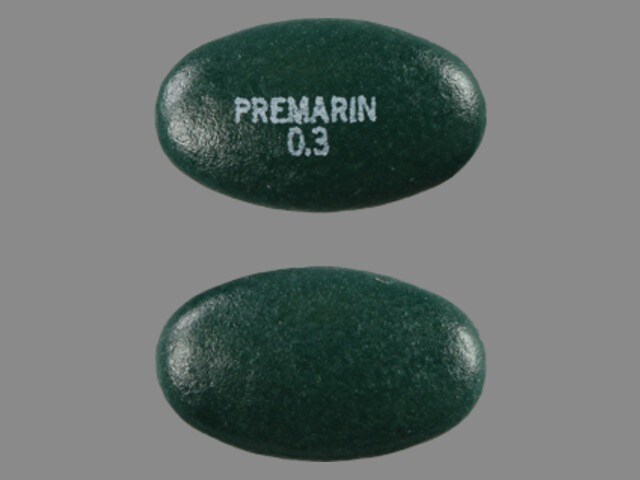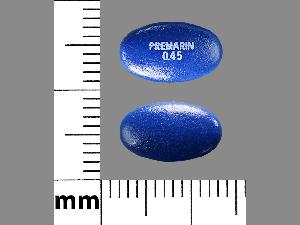What is Premarin?
Premarin is a medicine that contains a mixture of estrogen hormones.
Premarin is used after menopause to:
- Reduce moderate to severe hot flashes.
Estrogens are hormones made by a woman's ovaries. The ovaries normally stop making estrogens when a woman is between 45 and 55 years old. This drop in body estrogen levels causes the "change of life" or menopause (the end of monthly menstrual periods). Sometimes, both ovaries are removed during an operation before natural menopause takes place. The sudden drop in estrogen levels causes "surgical menopause."
When the estrogen levels begin dropping, some women get very uncomfortable symptoms, such as feelings of warmth in the face, neck, and chest, or sudden strong feelings of heat and sweating ("hot flashes" or "hot flushes"). In some women the symptoms are mild, and they will not need to take estrogens. In other women, symptoms can be more severe.
- Treat menopausal changes in and around the vagina
You and your healthcare provider should talk regularly about whether you still need treatment with Premarin to control these problems. If you use Premarin only to treat your menopausal changes in and around your vagina, talk with your healthcare provider about whether a topical vaginal product would be better for you.
- Help reduce your chances of getting osteoporosis (thin weak bones)
Osteoporosis from menopause is a thinning of the bones that makes them weaker and easier to break. If you use Premarin only to prevent osteoporosis due to menopause, talk with your healthcare provider about whether a different treatment or medicine without estrogens might be better for you.
Weight-bearing exercise, like walking or running, and taking calcium (1500 mg/day of elemental calcium) and vitamin D (400–800 IU/day) supplements may also lower your chances of getting postmenopausal osteoporosis. It is important to talk about exercise and supplements with your healthcare provider before starting them.
You and your healthcare provider should talk regularly about whether you still need treatment with Premarin.
Premarin is also used to:
- Treat certain conditions in women before menopause if their ovaries do not make enough estrogen naturally.
- Ease symptoms of certain cancers that have spread through the body, in men and women
What is the most important information I should know about Premarin?
- Using estrogen-alone may increase your chance of getting cancer of the uterus (womb). Report any unusual vaginal bleeding right away while you are using Premarin. Vaginal bleeding after menopause may be a warning sign of cancer of the uterus (womb). Your healthcare provider should check any unusual vaginal bleeding to find the cause.
- Do not use estrogen-alone to prevent heart disease, heart attacks, or dementia (decline of brain function)
- Using estrogen-alone may increase your chances of getting strokes or blood clots
- Using estrogen-alone may increase your chance of getting dementia, based on a study of women 65 years of age or older
- Do not use estrogens with progestins to prevent heart disease, heart attacks, strokes, or dementia
- Using estrogens with progestins may increase your chances of getting heart attacks, strokes, breast cancer, or blood clots
- Using estrogens with progestins may increase your chance of getting dementia, based on a study of women 65 years of age or older
- You and your healthcare provider should talk regularly about whether you still need treatment with Premarin
Who should not take Premarin?
Do not take Premarin if you:
- Have unusual vaginal bleeding
- Currently have or have had certain cancers
- Estrogens may increase the chance of getting certain types of cancers, including cancer of the breast or uterus. If you have or have had cancer, talk with your healthcare provider about whether you should use Premarin.
- Had a stroke or heart attack
- Currently have or have had blood clots
- Currently have or have had liver problems
- Have been diagnosed with a bleeding disorder
- Are allergic to Premarin or any of its ingredients. See the end of this guide for a list of ingredients in Premarin.
- Think you may be pregnant
What should I tell my healthcare provider before taking Premarin?
Tell your healthcare provider
- If you have any unusual vaginal bleeding. Vaginal bleeding after menopause may be a warning sign of cancer of the uterus (womb). Your healthcare provider should check any unusual vaginal bleeding to find out the cause.
- About all of your medical problems. Your healthcare provider may need to check you more carefully if you have certain conditions, such as asthma (wheezing), epilepsy (seizures), diabetes, migraine, endometriosis, lupus, problems with your heart, liver, thyroid, kidneys, or have high calcium levels in your blood.
- About all the medicines you take. This includes prescription and nonprescription medicines, vitamins, and herbal supplements. Some medicines may affect how Premarin works. Premarin may also affect how your other medicines work.
- If you are going to have surgery or will be on bedrest. You may need to stop taking Premarin.
- If you are breastfeeding. The hormones in Premarin can pass into your milk.
How should I take Premarin?
- Take one Premarin tablet at the same time each day
- If you miss a dose, take it as soon as possible. If it is almost time for your next dose, skip the missed dose and go back to your normal schedule. Do not take 2 doses at the same time.
- Estrogens should be used at the lowest dose possible for your treatment only as long as needed. You and your healthcare provider should talk regularly (for example, every 3 to 6 months) about the dose you are taking and whether you still need treatment with Premarin.
- If you see something that resembles a tablet in your stool, talk to your healthcare provider.
- Take Premarin with or without food.
What are the possible side effects of Premarin?
Side effects are grouped by how serious they are and how often they happen when you are treated.
Serious, but less common side effects include:
- Heart attack
- Stroke
- Blood clots
- Dementia
- Breast cancer
- Cancer of the lining of the uterus (womb)
- Cancer of the ovary
- High blood pressure
- High blood sugar
- Gallbladder disease
- Liver problems
- Enlargement of benign tumors of the uterus ("fibroids")
- Severe allergic reactions
Call your healthcare provider right away if you get any of the following warning signs or any other unusual symptoms that concern you:
- New breast lumps
- Unusual vaginal bleeding
- Changes in vision or speech
- Sudden new severe headaches
- Severe pains in your chest or legs with or without shortness of breath, weakness and fatigue
- Swollen lips, tongue and face
Less serious, but common side effects include:
- Headache
- Breast pain
- Irregular vaginal bleeding or spotting
- Stomach/abdominal cramps/bloating
- Nausea and vomiting
- Hair loss
- Fluid retention
- Vaginal yeast infection
These are not all the possible side effects of Premarin. For more information, ask your healthcare provider or pharmacist for advice about side effects. You may report side effects to FDA at 1-800-FDA-1088.
What can I do to lower my chances of getting a serious side effect with Premarin?
- Talk with your healthcare provider regularly about whether you should continue taking Premarin
- If you have a uterus, talk to your healthcare provider about whether the addition of a progestin is right for you. The addition of a progestin is generally recommended for women with a uterus to reduce the chance of getting cancer of the uterus (womb).
- See your health care provider right away if you get vaginal bleeding while taking Premarin
- Have a pelvic exam, breast exam and mammogram (breast X-ray) every year unless your healthcare provider tells you something else. If members of your family have had breast cancer or if you have ever had breast lumps or an abnormal mammogram, you may need to have breast exams more often.
- If you have high blood pressure, high cholesterol (fat in the blood), diabetes, are overweight, or if you use tobacco, you may have higher chances for getting heart disease. Ask your healthcare provider for ways to lower your chances of getting heart disease.
Premarin Images
General information about the safe and effective use of Premarin
Medicines are sometimes prescribed for conditions that are not mentioned in patient information leaflets. Do not take Premarin for conditions for which it was not prescribed. Do not give Premarin to other people, even if they have the same symptoms you have. It may harm them.
This guide provides a summary of the most important information about Premarin. If you would like more information, talk with your healthcare provider or pharmacist.
How should I store Premarin?
Store at 20° to 25°C (68° to 77°F); excursions permitted to 15° to 30°C (59° to 86°F).
Keep Premarin out of the reach of children
What are the ingredients in Premarin?
Active ingredients: contains a mixture of conjugated estrogens, which are a mixture of sodium estrone sulfate and sodium equilin sulfate and other components including sodium sulfate conjugates, 17 α-dihydroequilin, 17 α-estradiol, and 17 β-dihydroequilin.
Inactive ingredients: calcium phosphate tribasic, hydroxypropyl cellulose, microcrystalline cellulose, powdered cellulose, hypromellose, lactose monohydrate, magnesium stearate, polyethylene glycol, sucrose and titanium dioxide.
The color ingredients are:
0.3 mg tablet (green color): D&C Yellow No. 10 and FD&C Blue No. 2.
0.45 mg tablet (blue color): FD&C Blue No. 2.
0.625 mg tablet (maroon color): FD&C Blue No. 2 and FD&C Red No. 40.
0.9 mg tablet (white color): D&C Red No. 30 and D&C Red No. 7.
1.25 mg tablet (yellow color): black iron oxide, D&C Yellow No. 10, and FD&C Yellow No. 6.









